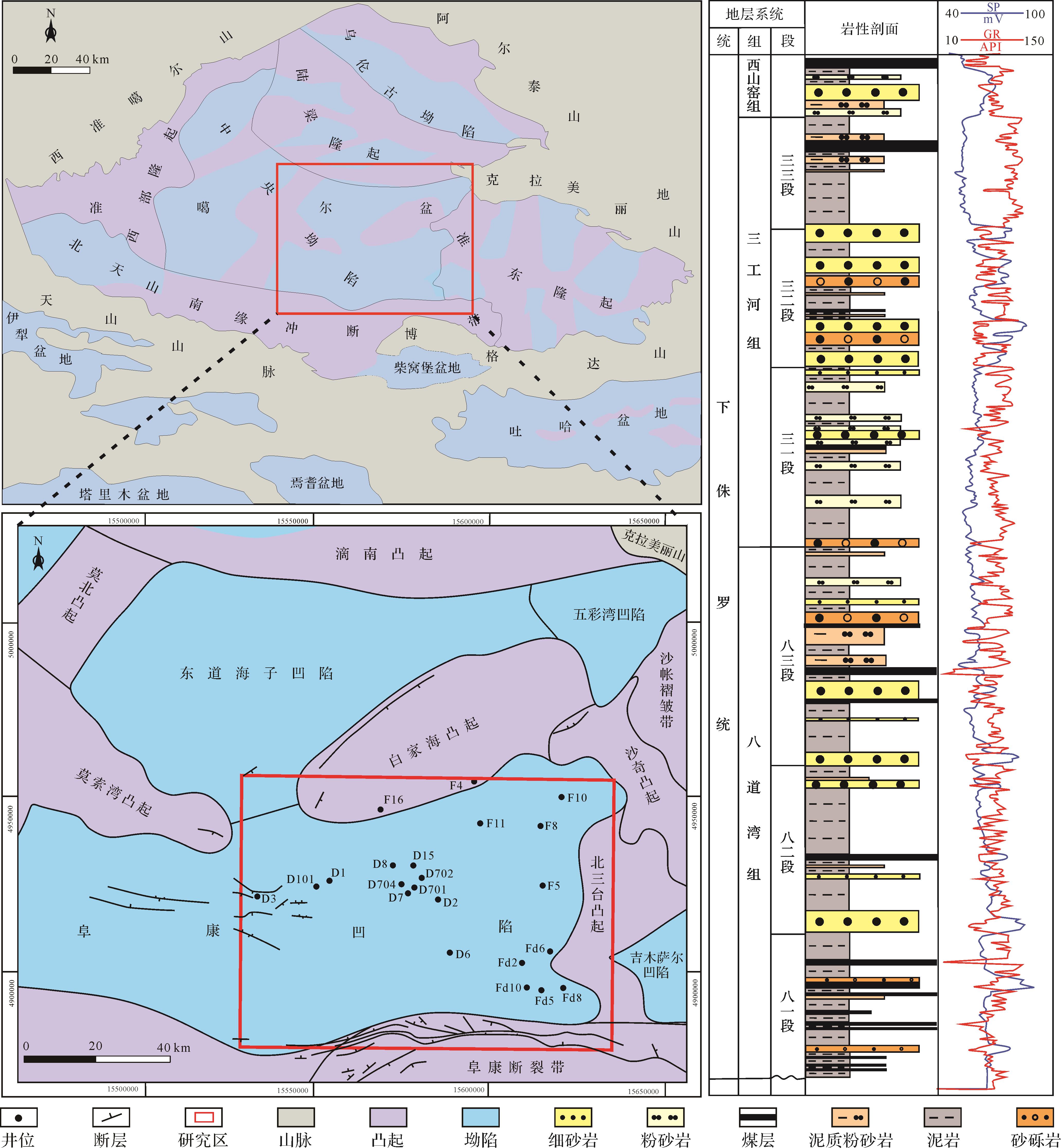-
准噶尔盆地是中国西北部重要的大型含油气盆地,阜康凹陷位于准噶尔盆地中央坳陷东部,是盆地最重要的生烃凹陷之一[1⁃5]。目前对阜康凹陷东部侏罗系的物源研究主要集中在中、上侏罗统[6⁃10],下侏罗统物源研究较少且尚存争议,核心问题在于除了克拉美丽山和北天山两大物源体系之外,下侏罗统八道湾组和三工河组是否存在东南部博格达山物源输入,其影响程度和范围等还不明确。部分学者[5,11⁃13]认为研究区下侏罗统可能不发育博格达山物源,但也有部分学者[14⁃16]揭示了部分博格达山物源体系存在的证据。随着研究区油气勘探的不断深入,厘清下侏罗统物源特征,对于划定有利勘探区带和寻找地层岩性圈闭等至关重要。此外,物源体系特征是盆山耦合分析的基础,对岩相古地理、沉积体系和区域构造演化研究等具有重要的意义。本次研究利用研究区钻井及野外典型剖面实物资料,通过古流向、碎屑组分、重矿物和阴极发光等综合分析,探讨了阜康凹陷中东部下侏罗统的物源区母岩性质及物源方向,分析了博格达山隆起对研究区沉积发育的影响,以期为盆地油气勘探开发提供相应支撑。
-
阜康凹陷位于准噶尔盆地腹部中央坳陷处,是盆地内次级构造单元之一(图1)。研究区位于阜康凹陷中东部,其东部与北三台凸起带相邻,西与阜康凹陷西部相接,南至阜康断裂带,北接白家海凸起(图1)。准噶尔盆地经历了海西期至喜山期的多期次构造叠加,构造特征较为复杂。海西运动导致盆地早期沉积具有明显的分割性特征,北三台凸起与白家海凸起开始隆升,吉木萨尔凹陷与东道海子凹陷开始形成;燕山运动及随后的喜马拉雅构造运动导致盆地开始向北逐渐抬升,最终形成了构造上南低北高、沉积上南厚北薄的特征[17⁃18]。

图 1 准噶尔盆地阜康凹陷构造区划、主要井位及地层柱状图
Figure 1. Structural outline map, well locations and stratigraphic column of Fukang Depression, Junggar Basin
研究区地层从老到新依次发育石炭系、二叠系、三叠系、侏罗系、白垩系、古近系和新近系及第四系。下侏罗统八道湾组可分为八一段、八二段和八三段(图1),与下伏三叠系呈区域不整合接触,主要为一套灰绿色砾岩、砂岩、泥岩夹煤层。三工河组包括三一段、三二段和三三段,其底部含砾,以泥岩和粉砂岩为主,上部发育一套中砂岩与泥岩夹砾岩。阜康凹陷油气资源丰富,具有良好的成藏条件,历经半个多世纪的油气勘探,已经发现了一批高产油气田[17,19]。目前,阜康凹陷侏罗系油气勘探重点层主要集中在中、上侏罗统,对下侏罗统的油气地质认识还较为薄弱,已不能满足当前勘探需要,在盆地整体南倾的构造背景下,其物源体系的研究对下一步油气勘探具有重要的指导意义。
-
碎屑岩组分和结构特征能够直接反映源区特征和沉积构造背景。通常,随着搬运距离的增大,岩石中稳定矿物含量也越高,不稳定矿物含量逐渐减少[20⁃22]。因此,可以依据碎屑组分特征判断物源方向。根据目标层位样品的石英、长石和岩屑含量统计结果,应用Dickinson碎屑三角图解[23],对源区构造背景进行了分析。
选取研究区内及周缘郝家沟—头屯河剖面、三工河剖面以及水西沟剖面和岩心较为齐全的D2井进行了碎屑组分特征分析,采样位置见图2。结果显示样品碎屑成分以石英、长石以及岩屑为主,而且岩屑含量最高,石英次之,详细统计见表1。

图 2 碎屑组分特征分析采样剖面和井位位置(底图据Google Earth修改)
Figure 2. Sampling profile and well locations for analysis of debris components (by Google Earth)
表 1 头屯河剖面、三工河剖面、水西沟剖面及D2井样品碎屑颗粒组成统计表
Table 1. Clastic particles of Lower Jurassic samples from Toutunhe, Sangonghe and Shuixigou sections, and well D2
样品 编号 单晶 石英/% 长石/% 岩屑 总量/% 多晶石英/% 火山岩屑/% 沉积岩屑/% 变质岩屑/% tth-4 20 3 77 6 59 6 6 tth-11 18 8 74 5 49 6 14 tth-12 22 12 76 5 56 7 8 SGH-8 25 13 62 8 41 3 10 SGH-11 23 10 67 6 44 4 13 SGH-12 19 13 68 11 47 3 7 SGH-14 24 6 70 5 48 4 13 SGH-15 23 7 70 6 48 4 12 SGH-16 25 15 60 5 41 4 10 SGH-17 27 20 53 7 33 3 10 SGH-18 26 15 59 5 40 5 9 SXG-1 32 13 58 7 30 3 18 SXG-3 28 7 65 4 43 3 15 SXG-5 30 8 61 2 44 4 11 SXG-6 31 8 61 3 42 4 12 SXG-8 23 12 68 7 45 3 13 SXG-9 22 10 66 4 45 4 13 SXG-14 23 8 66 4 45 4 13 SXG-16 20 14 66 8 46 4 8 SXG-17 15 2 83 5 55 8 15 SXG-18 38 10 52 4 35 6 7 D2-1 26 15 66 10 34 4 18 D2-3 33 16 60 9 31 3 17 D2-6 32 18 65 12 34 3 16 D2-8 32 17 61 9 31 4 17 D2-22 25 16 65 11 33 3 18 D2-23 27 14 73 10 38 8 17 D2-26 31 15 61 11 28 3 19 D2-27 26 18 65 9 37 4 15 D2-28 26 11 65 8 38 3 16 D2-31 17 13 76 10 45 3 18 D2-33 24 14 69 11 36 3 19 D2-35 20 13 73 10 42 4 17 D2-36 16 15 67 10 36 3 18 D2-37 22 12 69 9 36 4 20 D2-39 29 11 57 8 34 3 12 D2-40 21 14 60 8 35 3 14 D2-41 20 17 60 9 32 3 16 郝家沟—头屯河剖面下侏罗统成分成熟度较低,岩屑极为丰富(含量介于74%~77%),其次是单晶石英(含量介于18%~22%),多晶石英(含量介于5%~6%)以燧石和变质石英岩屑为主,并且以燧石居多;在非稳定隐晶岩屑中,火成岩屑较为丰富(含量介于49%~59%),并以酸性喷出岩岩屑为主;变质岩和沉积岩岩屑含量较少(含量介于12%~20%)。三工河剖面碎屑成分成熟度也较低,岩屑含量介于53%~70%,除不稳定岩屑外,主要是单晶石英(含量介于19%~27%),多晶石英(含量介于5%~11%)以燧石和变质石英岩屑为主;在非稳定隐晶岩屑中,火成岩屑含量介于33%~48%,以中酸性喷出岩岩屑为主,含基性喷出岩岩屑;沉积岩岩屑较少(含量介于3%~5%)。水西沟剖面中岩屑同样富集(含量介于52%~83%),成分成熟度较低,石英以单晶石英为主(含量介于15%~38%),多晶石英(含量介于2%~8%)以燧石和变质石英岩屑为主;在非稳定隐晶岩屑中,火成岩屑含量介于30%~55%,以中酸性喷出岩岩屑为主,含基性喷出岩岩屑;沉积岩岩屑含量较少(含量介于3%~8%),变质岩岩屑含量中等(含量介于8%~18%)。
研究区内D2井目的层成分成熟度依然不高,岩屑含量介于60%~76%,碎屑颗粒中除不稳定岩屑外,单晶石英含量介于16%~33%,多晶石英含量为8%~12%,以变质石英岩屑为主;相对于野外剖面样品,长石含量有所增加(含量介于11%~18%),在非稳定隐晶岩屑中,火成岩屑含量介于31%~45%,以喷出岩岩屑为主;沉积岩岩屑含量少(含量介于3%~8%)。
应用Dickinson(1985)碎屑三角图进行投点,得到了Qm-F-Lt以及Qp-Lv-Ls碎屑成分三角图(图3)。Qm-F-Lt图解显示三工河剖面八道湾组及三工河组的石英含量变化不大(20%~30%),但长石含量差异较大(0~19%),且岩屑含量较高(50%~70%)。水西沟剖面八道湾组及三工河组各样品石英含量(16%~40%)和长石含量(0~19%)变化均较大,且岩屑含量较高(40%~80%)。样品点主要集中在再旋回造山带范围内,少数具有岩浆弧背景。Qp-Lv-Ls图解还显示样品具有岛弧造山带背景。整体上,研究区下侏罗统物源区构造背景以再旋回造山带和岛弧造山带等为主。
-
古水流和古斜坡方向是物源研究的基础数据[24⁃26],可通过分析沉积组构和沉积构造的实测数据恢复。前积层理、波痕和砾石排列等与古水流方向密切相关,是判断古流向最直接的证据[26]。在野外调查过程中,所观察到的部分前积纹层及其所指示的古水流方向如图4所示。通常,如果地层倾角较小,则前积层的产状和地层的原始产状较为一致;如果地层倾角较大,则须对古流向进行修正,此过程通常使用赤平投影法,来获取地层初始时前积层的产状,从而进行古流向的判断[26]。本次研究的岩层出露倾角普遍较大,所以通过赤平投影法对剖面古流向进行复原,并根据所恢复的古流向绘制玫瑰花图,再结合剖面位置以及前人研究[13,16,27⁃28]得到了研究区古流向分析图(图5,6)。

图 4 研究区典型野外地质剖面的古水流方向及素描图
Figure 4. Paleocurrent direction and geological sketch of typical field geological sections in the study area

图 5 阜康凹陷中东部下侏罗统八道湾组古流向分析图
Figure 5. Paleocurrent analysis of Lower Jurassic Badaowan Formation, central eastern Fukang Depression

图 6 阜康凹陷中东部下侏罗统三工河组古流向分析图
Figure 6. Paleocurrent analysis of Lower Jurassic Sangonghe Formation, central eastern Fukang Depression
八道湾组古水流分析揭示其物源包含北北东、南东以及南西三个方向,分别指示克拉美丽山、博格达山以及北天山物源体系。依据玫瑰花图,发现了北北东方向以及南南西方向的古水流,证实了克拉美丽山物源体系与北天山物源体系的存在,同时还存在东南方向的古水流,揭示了博格达山物源体系的存在,且为博格达山在该期已在东部发生隆升提供了证据。三工河组古流向较八道湾组皆有所偏转,博格达山南部古水流由南西方向偏转为南向,北缘古水流由北西向偏转为北东向。推测八道湾组沉积时期部分物源输入来自博格达山东缘,而三工河组物源输入更有可能来自西部隆起,由此导致了三工河组古水流方向较八道湾组偏转的结果,进一步推断三工河组沉积时期博格达山西部地形较八道湾组沉积时期要高,并能够为研究区提供物源。
-
分别对郝家沟—头屯河剖面、三工河剖面、水西沟剖面样品及研究区内钻井岩心的实测重矿物类型数据进行了统计分析(图7,8)。

图 7 研究区八道湾组重矿物类型对比图
Figure 7. Comparison of heavy mineral types of the Badaowan Formation in the study area

图 8 研究区三工河组重矿物类型对比图
Figure 8. Comparison of heavy mineral types of the Sangonghe Formation in the study area
结果显示,八道湾组重矿物以磁铁矿为主,含量几乎都在70%以上。郝家沟—头屯河剖面与其余剖面以及钻井岩心样品实测重矿物类型均有较大的差异,其褐铁矿含量远大于其余剖面以及钻井岩心样品,由此判断其物源与其余剖面以及研究区不一致。博格达山前三工河剖面以及水西沟剖面,重矿物类型及含量都基本相同,指示其可能受同一源区控制。三工河剖面与研究区内钻井岩心样品重矿物含量的对比显示,其重矿物类型基本相同,以磁铁矿、锆石、磷灰石为主,但钻井岩心样品中角闪石的含量较高。重矿物类型的异同说明有相同物源区存在,此物源区推断为博格达山物源区,也受不同的叠加物源输入影响,推断为克拉美丽山物源区的影响。三工河组重矿物类型对比图显示,郝家沟—头屯河剖面与其余剖面及钻井岩心样品的重矿物类型差别依然较大,说明其物源区与其余剖面及研究区的物源区存在较大差异,据此推断郝家沟—头屯河剖面以北天山物源为主。三工河剖面与钻井岩心样品中的重矿物含量基本一致,但存在微小差异,进一步证明了研究区下侏罗统以克拉美丽山为主要物源区,以博格达山为次要物源区的观点。
-
ZTR指数法是重矿物组合分析法的一种,是锆石、电气石以及石榴石总含量与透明矿物总含量之比,通常随ZTR指数增大,沉积区与物源区的距离也逐渐增大[13]。本次研究分别对郝家沟—头屯河剖面、三工河剖面、水西沟剖面样品及研究区内钻井岩心样品进行了重矿物组合特征分析,并通过在室内对数据的计算与处理绘制了ZTR指数平面气泡图(图9)。

图 9 野外地质剖面及钻井岩心样品ZTR指数平面气泡分布图
Figure 9. Plane bubble distribution of zircon⁃tourmaline⁃rutile (ZTR) maturity index of outcrop and drill⁃core samples for field geological profile
根据ZTR平面气泡图,八道湾组ZTR值主要在北北西方向上存在增加趋势,说明此时研究区物源来自东南方向。由于进行岩心观察时,八道湾组层位显示较短,诸多钻井缺乏八道湾组岩心,所以八道湾组数据较少,但根据前人研究[13,29],此时研究区主要是克拉美丽山物源。三工河组ZTR值主要在北西以及南西两个方向存在增加趋势,说明此时在南东以及北东方向存在两个物源区,推断为博格达山以及克拉美丽山物源区。此结论与前文古流向研究所得结论相一致。
-
聚类分析又称簇分析或群分析,是根据样本或变量之间的相关度以及相似性把样本或变量进行相似分类的方法[30]。根据研究目的和对象的不同,聚类分析可分为Q型和R型两类。Q型聚类分析是对样本的分类,是通过同一变量把不同样本联系起来,并对这一相同变量进行对比分析,研究样本之间的相关性,完成对不同样本的相似划分;R型聚类分析是对变量的分类,是对相同样本间的差异变量部分进行对比分析,从而确定变量之间相似程度,并在此基础上完成对不同变量的分类[31]。
本次研究分别对郝家沟—头屯河剖面、三工河剖面、水西沟剖面样品以及研究区内钻井岩心实测重矿物数据进行了R型聚类分析(图10,11)。结果显示,重矿物在D2井共有4种重矿物组合:①辉石、板钛矿、石榴石、蓝晶石、榍石、绿帘石;②锆石、电气石;③褐铁矿、锡石;④磷灰石、云母。依据①推断D2井物源区所存在的母岩类型为高级变质岩、基性火山岩;其余组合类型表示其母岩类型主要为酸性火山岩。在D6井共有3种重矿物组合:①锡石、板钛矿、石榴石、电气石、蓝晶石、榍石、褐铁矿;②绿帘石、辉石;③磷灰石、云母。其中,①组合类型所象征的母岩类型主要为酸性火山岩、高级变质岩;②组合类型所象征的母岩类型主要为基性火山岩、高级变质岩;③组合类型所象征的母岩类型主要为酸性火山岩。在D7井共有4种重矿物组合:①锡石、板钛矿、电气石、石榴石、蓝晶石;②绿帘石、辉石、角闪石;③磁铁矿、云母;④褐铁矿、榍石。其中,①组合类型所象征的母岩类型主要为酸性火山岩、高级变质岩;②组合类型所象征的母岩类型主要为高级变质岩;③和④组合类型所象征的母岩类型主要为酸性火山岩。在D15井共有3种重矿物组合:①电气石、褐铁矿、石榴石、蓝晶石、榍石、绿帘石;②锆石、磷灰石;③角闪石、锡石。其中,①组合类型所象征的母岩类型主要为酸性火山岩、高级变质岩;②和③组合类型所象征的母岩类型主要为酸性火山岩。在D701井共有4种重矿物组合:①辉石、板钛矿、石榴石、蓝晶石、锡石、电气石;②褐铁矿、云母;③绿帘石、榍石;④磷灰石、磁铁矿。其中,①组合类型所象征的母岩类型主要为高级变质岩、酸性火山岩、基性火山岩;②和④组合类型所象征的母岩类型主要为酸性火山岩;③组合类型所象征的母岩类型主要为酸性火山岩、高级变质岩。

图 10 D2、D6、D7、D15以及D701井R型聚类分析树状图
Figure 10. R⁃type cluster analysis tree for D2, D6, D7, D15 and D701 wells

图 11 头屯河剖面、三工河剖面、水西沟剖面R型聚类分析树状图
Figure 11. R⁃type cluster analysis trees for Toutunhe, Sangonghe and Shuixigou sections
R型聚类分析树状图揭示郝家沟—头屯河剖面共有2种重矿物组合:①褐铁矿、角闪石、黄铁矿;②磁铁矿、锡石。推断郝家沟—头屯河剖面物源区母岩类型主要为酸性火山岩。在三工河剖面共有2种重矿物组合:①褐铁矿、黄铁矿;②角闪石、锡石。推断三工河剖面物源区的主要母岩类型为酸性火山岩。在水西沟剖面有1种重矿物组合:褐铁矿、角闪石、黄铁矿、锡石,推断水西沟剖面物源区的主要母岩类型同样为酸性火山岩。
依据对研究区内及周缘郝家沟—头屯河剖面、三工河剖面以及水西沟剖面和研究区内5口钻井岩心的R型聚类分析,确定了研究区母岩类型以酸性火山岩、基性火山岩以及高级变质岩源岩为主。结合准南侏罗系潜在物源区母岩特征(表2),与研究区存在的三大潜在物源区基本一致,即克拉美丽山物源区、北天山物源区以及博格达山物源区。
-
阴极发光是物源分析的有效手段之一,它是由于电子束的轰击,从而使电能转化为光能所产生的现象[32]。因为造岩矿物源区的不同而产生不同的阴极发光特征,据此可以判断母岩性质和岩石成因等。在碎屑岩中,由于岩屑和长石的不稳定,通常选用石英进行阴极发光特征研究,进而分析物源特征。由于各晶体之间微量元素存在差异以及石英的多样化成因,导致阴极发光实验中的石英表现出不同的色彩特征,这更使得通过阴极发光下石英发光的不同色彩特征来推断其形成环境成为可能[33⁃35]。表3反映了石英阴极发光特征与源岩类型的关系。
表 3 石英阴极发光特征与源岩类型的关系(据文献[36]修改)
Table 3. Relationship between cathodoluminescence characteristics of quartz and source rock types(modified from reference [36])
类型 发光颜色 温度 源岩类型 Ⅰ 以蓝色、紫色为主 >573 ℃(快速冷却) 火山岩、深成岩、接触变质岩 Ⅱ 以棕褐色为主 >573 ℃(缓慢冷却) 高级变质岩(变质火山岩、变质石英岩) 300 ℃~573 ℃ 低级变质岩(接触变质岩、区域变质岩、回火沉积岩的自生石英) Ⅲ 不发光 <300 ℃ 沉积岩中自生石英 选取研究区内及周缘郝家沟—头屯河剖面、三工河剖面以及水西沟剖面和研究区内D2井进行了阴极发光特征分析(图12)。结果显示,阴极发光薄片中石英以蓝色和蓝紫色为主,少量石英颜色呈现为褐红色至红色,局部存在不发光石英。以蓝色或蓝紫色阴极发光特征为主的石英指示其源岩是火山岩、深成岩;以褐红色阴极发光为主则指示变质火山岩、变质石英岩源区;而不发光石英主要来自沉积岩源区。因此,石英阴极发光特征揭示的源区性质与前述R型聚类分析中所得结论一致。
-
通过对阜康凹陷中东部下侏罗统八道湾组和三工河组碎屑组分、古水流、重矿物特征及石英阴极发光等综合分析,认为研究区下侏罗统受控于北部、南部和东南物源体系,其中,以北部和东南部物源体系的影响最大。在前人研究过程中,吕嵘[37]、孙海宁等[38]以及方世虎等[39]认为下侏罗统物源区以造山带为主,而且物源区距沉积区较远。通过对研究区周缘郝家沟—头屯河剖面、三工河剖面及水西沟剖面和D2井进行碎屑组分特征分析,同样认为造山带为其主要物源区。古水流分析中所得到的博格达山东部在八道湾组沉积期已开始隆升的认识,也符合上述物源区离沉积区较远的观点。古水流分析表明在下侏罗统沉积时期博格达山已经从东部开始隆起,并能够为研究区提供部分物源输入,但此时研究区的主物源区依然是克拉美丽山,此时印支运动的影响,加剧了东北部地区的构造抬升,导致克拉美丽山强烈隆起,并成为研究区的主要物质来源。此外,张琴等[16]通过地层倾角测井以及地震相分析等手段,也证实了东南方向古水流的存在,说明此时博格达山已经初步隆起。由于博格达山作为天山重要支脉分隔了准噶尔盆地和吐哈盆地,所以博格达山的隆起对于吐哈盆地同样拥有重要意义,除准噶尔盆地南部以外,吐哈盆地北部的相关分析也为博格达山的隆起时间提供了证据。前人[40⁃41]在吐哈盆地北部地区发现二叠纪—早侏罗世古水流方向由北转向南,表明二叠纪—早侏罗世期间博格达山发生了初始隆升。喻春辉等[42]也证实了博格达山两侧下侏罗统古水流差异的存在,并由此推断吐哈盆地和准噶尔盆地在早侏罗世或更早时期便已经分开。与二叠纪—三叠纪沉积体系相比,早中侏罗世吐哈盆地内反映的是湖成平原环境[43],同样表明博格达山此时已经隆起。宋承文[44]对吐哈盆地北部山前带下侏罗统三工河组和八道湾组进行了岩石学特征分析,认为其物源来自盆地北部。Hendrix[45]依据在博格达山南北两侧的侏罗纪样品中放射状燧石比例的增加,判断此时吐哈盆地已与准噶尔盆地南部分离。以上这些发现,均证实了博格达山在早侏罗世已经开始隆起。
研究区的母岩类型主要为火山岩以及深成岩,而陈哲夫等[46]也认为博格达山几乎完全由镁铁质火山岩和相关的深成岩组成。重矿物聚类分析显示母岩以酸性喷出岩为主,其次是基性喷出岩,也与准南侏罗系潜在物源区母岩类型相符合。ZTR平面气泡图更是直观地显示了东南博格达山物源体系的存在。同样,在博格达山南侧吐哈盆地北部山前带重矿物分析结果也与此认识一致,管彧照等[47]开展了吐哈盆地北部重矿物组合平面特征分析,认为吐哈盆地北缘博格达山在早侏罗世便已隆起并遭受剥蚀。吴青鹏等[48]对吐哈盆地内台北凹陷西部侏罗系沉积相的研究,也证实了博格达山在早侏罗世就已开始向盆地内提供物源。樊太亮[49]采用重矿物ZTR指数以及地震剖面分析等方法展开研究,认为吐哈盆地北部山前带中下侏罗统主要受北物源控制。田兵[50]根据重矿物组合关系及发育规律,认为吐哈盆地山前带中下侏罗统沉积物发育两大物源体系,北部博格达山物源体系便是其中之一,且作为近端物源存在。李阳[51]也曾运用重矿物分析和砂岩百分含量分析方法,揭示了吐哈盆地北部山前带的巴喀地区下侏罗统沉积时期物源和古水流方向是由北向南的。
本次研究还通过统计准噶尔盆地内相关钻井砂地比数据,结合前人研究资料,绘制了研究区八道湾组和三工河组沉积相平面展布图(图13)。从前人研究[52⁃53]可知,八道湾组自下而上主要发育三角洲—湖泊—三角洲相;三工河组自下而上主要发育三角洲—湖泊相。八道湾组沉积时期,克拉美丽山的隆起为研究区持续提供物质来源,三角洲沉积大幅向盆地推进,砂体发育好,连片性强,厚度较大,沉积微相以分流河道为主,从东北向西南呈条带状流入研究区,砂地比值高,而在分流河道间,砂岩含量低,砂地比值同样较低。此时,克拉美丽山物源体系是研究区最主要的物质来源,博格达山物源体系只对研究区产生些微影响。八道湾组沉积之后,三工河组开始大规模的湖侵,克拉美丽山物源供应持续减弱,滨浅湖相带面积扩大,三角洲相面积缩小。此时,博格达山逐渐隆起,其对研究区的物源供应逐渐增强,三角洲砂体发育好,连片性强。尽管如此,但克拉美丽山物源体系对研究区沉积的影响仍然较大,但伴随博格达山的逐渐隆起,两大物源体系形成相互对峙、消长的格局。
-
(1) 准噶尔盆地阜康凹陷中东部早侏罗世主要物源区为再旋回造山带以及岛弧造山带,其母岩类型主要为酸性火山岩、基性火山岩以及高级变质岩。
(2) 研究区下侏罗统八道湾组沉积期以克拉美丽山物源输入为主,南部北天山及博格达山影响程度有限;至三工河组沉积期,由于博格达山自东向西构造隆升的加剧,其物源供应能力逐渐增强,此时,在东北部物源继承性输入基础上,还叠加了来自东南的博格达山的分支物源,使其具有显著的多物源叠加特征。
(3) 阜康凹陷下侏罗统物源方向与物源特征的变化,与区域构造演化过程密切相关,较为清晰地响应了博格达山在早侏罗世自东向西、由慢及快的隆升过程。
(4) 准噶尔盆地阜康凹陷以构造南倾为主,下侏罗统多物源体系的发育,尤其是东南向物源的叠加输入,有利于在南部斜坡带发育上倾尖灭型地层岩性圈闭,对于下侏罗统油气勘探开发具有重要的指示意义。
阜康凹陷下侏罗统物源变化对博格达山隆升的响应
doi: 10.14027/j.issn.1000-0550.2022.095
cstr: 32268.14.cjxb.62-1038.2022.095Provenance Change in the Lower Jurassic in Fukang Depression (Junggar Basin) and Its Response to the Uplift of the Bogda Mountains
-
摘要:
目的 准噶尔盆地阜康凹陷中东部下侏罗统八道湾组和三工河组是当前油气勘探的重点层位,但由于其物源体系尚不明确,严重制约了该区沉积体系研究和油气勘探进程。 方法 基于八道湾组和三工河组的碎屑成分、古流向、重矿物、阴极发光和砂地比平面分布等相关分析,对阜康凹陷中东部早侏罗世物源体系及对博格达山隆升的响应特征进行了探讨。 结果与结论 结果显示,研究区八道湾组主要受控于东北部克拉美丽山物源体系,北天山及博格达山物源的影响程度有限;而三工河组不仅存在继承性的克拉美丽山及北天山物源输入,又叠加了来自博格达山的分支物源,且博格达山物源的影响不断增强。研究区下侏罗统物源变化清晰地响应了博格达山自东向西不断增强的隆升过程。阜康凹陷南斜坡表现为构造南倾的特征,下侏罗统东南物源的存在为地层岩性圈闭的发育奠定了物质基础,对该区油气勘探具有重要的指示意义。
Abstract:Objective The Lower Jurassic Badaowan and Sangonghe Formations in the middle and eastern parts of the Fukang Depression are key intervals for oil and gas exploration, but they are restricted due to their unclear provenance. Methods In this study, the provenance was analyzed from rock clastic composition, paleocurrent analysis, heavy mineral composition, cathodoluminescence properties and the proportion of sandstone in the strata. [Results and Conclusions] The study area is dominated by the Karameri Mountain provenance during the Lower Jurassic, with limited Northern Tianshan and Bogda Mountains provenance. The Sangonghe Formation was influenced by provenances inherited from both the Kalameri Mountain and the northern Tianshan, enhanced by a superposed branch provenance from the Bogda Mountains. In the study area, which has a south-dipping structural background, it is clear that the provenance changed due to the increasing east-to-west uplift of the Bogda Mountains. This southeasterly Lower Jurassic provenance is the scenario for stratigraphic-lithological traps to develop on the southern slope of the Fukang Depression. This may be greatly significant for future oil and gas exploration.
-
Key words:
- Fukang Depression /
- Bogda Mountains /
- Lower Jurassic /
- provenance analysis /
- depositional systems
-
表 1 头屯河剖面、三工河剖面、水西沟剖面及D2井样品碎屑颗粒组成统计表
Table 1. Clastic particles of Lower Jurassic samples from Toutunhe, Sangonghe and Shuixigou sections, and well D2
样品 编号 单晶 石英/% 长石/% 岩屑 总量/% 多晶石英/% 火山岩屑/% 沉积岩屑/% 变质岩屑/% tth-4 20 3 77 6 59 6 6 tth-11 18 8 74 5 49 6 14 tth-12 22 12 76 5 56 7 8 SGH-8 25 13 62 8 41 3 10 SGH-11 23 10 67 6 44 4 13 SGH-12 19 13 68 11 47 3 7 SGH-14 24 6 70 5 48 4 13 SGH-15 23 7 70 6 48 4 12 SGH-16 25 15 60 5 41 4 10 SGH-17 27 20 53 7 33 3 10 SGH-18 26 15 59 5 40 5 9 SXG-1 32 13 58 7 30 3 18 SXG-3 28 7 65 4 43 3 15 SXG-5 30 8 61 2 44 4 11 SXG-6 31 8 61 3 42 4 12 SXG-8 23 12 68 7 45 3 13 SXG-9 22 10 66 4 45 4 13 SXG-14 23 8 66 4 45 4 13 SXG-16 20 14 66 8 46 4 8 SXG-17 15 2 83 5 55 8 15 SXG-18 38 10 52 4 35 6 7 D2-1 26 15 66 10 34 4 18 D2-3 33 16 60 9 31 3 17 D2-6 32 18 65 12 34 3 16 D2-8 32 17 61 9 31 4 17 D2-22 25 16 65 11 33 3 18 D2-23 27 14 73 10 38 8 17 D2-26 31 15 61 11 28 3 19 D2-27 26 18 65 9 37 4 15 D2-28 26 11 65 8 38 3 16 D2-31 17 13 76 10 45 3 18 D2-33 24 14 69 11 36 3 19 D2-35 20 13 73 10 42 4 17 D2-36 16 15 67 10 36 3 18 D2-37 22 12 69 9 36 4 20 D2-39 29 11 57 8 34 3 12 D2-40 21 14 60 8 35 3 14 D2-41 20 17 60 9 32 3 16 表 2 准南侏罗系潜在物源区母岩特征(据文献[13])
Table 2. Characteristics of parent rock in the Jurassic potential provenance area of the Southern Junggar Basin(after reference [13])
物源区 母岩岩性 北天山 中—酸性火山岩、火山碎屑岩、凝灰岩 博格达山(西部) 中—基性火山岩;玄武岩;安山质玄武岩;花岗岩、流纹岩、火山碎屑岩 克拉美丽山 中—酸性喷出岩、火山碎屑岩;蛇绿岩带;斜长角闪岩;玄武岩、辉绿岩、辉长岩 表 3 石英阴极发光特征与源岩类型的关系(据文献[36]修改)
Table 3. Relationship between cathodoluminescence characteristics of quartz and source rock types(modified from reference [36])
类型 发光颜色 温度 源岩类型 Ⅰ 以蓝色、紫色为主 >573 ℃(快速冷却) 火山岩、深成岩、接触变质岩 Ⅱ 以棕褐色为主 >573 ℃(缓慢冷却) 高级变质岩(变质火山岩、变质石英岩) 300 ℃~573 ℃ 低级变质岩(接触变质岩、区域变质岩、回火沉积岩的自生石英) Ⅲ 不发光 <300 ℃ 沉积岩中自生石英 -
[1] 厚刚福,宋兵,陈扬,等. 准噶尔盆地阜康凹陷白垩系清水河组低位体系域充填模式及油气勘探意义[J]. 中国石油勘探,2021,26(5):74-82. Hou Gangfu, Song Bing, Chen Yang, et al. Filling model of Iowstand system tract of Cretaceous Qingshuihe Formation in Fukang Sag in Junggar Basin and its significance on petroleum exploration[J]. China Petroleum Exploration, 2021, 26(5): 74-82. [2] 何海清,支东明,唐勇,等. 准噶尔盆地阜康凹陷康探1井重大突破及意义[J]. 中国石油勘探,2021,26(2):1-11. He Haiqing, Zhi Dongming, Tang Yong, et al. A great discovery of well Kangtan 1 in the Fukang Sag in the Junggar Basin and its significance[J]. China Petroleum Exploration, 2021, 26(2): 1-11. [3] 柳妮,陈玉一,李疆,等. 准噶尔盆地阜康凹陷北部三工河组储层非均质性综合研究[J]. 地质与勘探,2020,56(2):451-464. Liu Ni, Chen Yuyi, Li Jiang, et al. A comprehensive research on reservoir heterogeneity of the Sangonghe Formation in the north of the Fukang Sag, Junggar Basin[J]. Geology and Exploration, 2020, 56(2): 451-464. [4] 鲍志东,刘凌,张冬玲,等. 准噶尔盆地侏罗系沉积体系纲要[J]. 沉积学报,2005,23(2):194-202. Bao Zhidong, Liu Ling, Zhang Dongling, et al. Depositional system frameworks of the Jurassic in Junggar Basin[J]. Acta Sedimentologica Sinica, 2005, 23(2): 194-202. [5] 陈丹丹,吉鸿杰,陶辉飞,等. 准东地区阜康凹陷南部中下侏罗统沉积特征与沉积演化模式[J]. 天然气地球科学,2015,26(11):2093-2106. Chen Dandan, Ji Hongjie, Tao Huifei, et al. Sedimentary characteristics and evolution model of the Middle-Early Jurassic on the south of Fukang Sag in eastern Junggar Basin[J]. Natural Gas Geoscience, 2015, 26(11): 2093-2106. [6] 靳军,文华国,向宝力,等. 准噶尔盆地东部阜东斜坡头屯河组物源分析[J]. 岩性油气藏,2014,26(2):54-58,73. Jin Jun, Wen Huaguo, Xiang Baoli, et al. Provenance analysis of Middle Jurassic Toutunhe Formation in eastern Fukang slope, Junggar Basin[J]. Lithologic Reservoirs, 2014, 26(2): 54-58, 73. [7] 刘德志. 准中部4区块侏罗系头屯河组南部物源条件分析[J]. 内蒙古石油化工,2019,45(4):34-36. Liu Dezhi. Analysis of provenance condition in south part of Toutunhe Group in Jurassic system in block-4 of central part Jungar banner[J]. Inner Mongolia Petrochemical Industry, 2019, 45(4): 34-36. [8] 张敏,修金磊,陈林,等. 准噶尔盆地中部2、4区块侏罗系头屯河组物源体系及沉积演化特征[J]. 石油天然气学报,2014,36(6):45-50. Zhang Min, Xiu Jinlei, Chen Lin, et al. The provenance systems and characteristics of sedimentary evolution of Jurassic Toutunhe Formation in the 2nd and 4th blocks of central Junggar Basin[J]. Journal of Oil and Gas Technology, 2014, 36(6): 45-50. [9] 林潼,王东良,王岚,等. 准噶尔盆地南缘侏罗系齐古组物源特征及其对储层发育的影响[J]. 中国地质,2013,40(3):909-918. Lin Tong, Wang Dongliang, Wang Lan, et al. The provenance feature of Jurassic Qigu Formation and its effect on reservoir development in the southern margin of Junggar Basin[J]. Geology in China, 2013, 40(3): 909-918. [10] 卢炳雄,文华国,淡永,等. 准噶尔盆地阜康凹陷阜东斜坡齐古组储层控制因素及有利区预测[J]. 石油与天然气地质,2018,39(3):549-557. Lu Bingxiong, Wen Huaguo, Dan Yong, et al. Favorable accumulation region prediction and controlling factors of hydrocarbon accumulation of the Qigu Formation in the Fudong slope, Fukang Sag, Junggar Basin[J]. Oil & Gas Geology, 2018, 39(3): 549-557. [11] 苏真真,陈林,许涛,等. 准噶尔盆地中部2、4区块侏罗系头屯河组物源体系研究[J]. 石油地质与工程,2014,28(2):9-11. Su Zhenzhen, Chen Lin, Xu Tao, et al. Provenance system research of Jurassic Toutunhe Formation in 2, 4 blocks of the Middle of Junggar Basin[J]. Petroleum Geology and Engineering, 2014, 28(2): 9-11. [12] 张曰静. 准噶尔盆地腹部下侏罗统三工河组物源体系分析[J]. 新疆石油地质,2012,33(5):540-542. Zhang Yuejing. Provenance analysis of Jurassic Sangonghe Formation in hinterland of Junggar Basin[J]. Xinjiang Petroleum Geology, 2012, 33(5): 540-542. [13] 周天琪,吴朝东,袁波,等. 准噶尔盆地南缘侏罗系重矿物特征及其物源指示意义[J]. 石油勘探与开发,2019,46(1):65-78. Zhou Tianqi, Wu Chaodong, Yuan Bo, et al. New insights into multiple provenances evolution of the Jurassic from heavy minerals characteristics in southern Junggar Basin, NW China[J]. Petroleum Exploration and Development, 2019, 46(1): 65-78. [14] 龚清. 准噶尔盆地南缘和东缘地区侏罗系沉积特征及构造背景[D]. 北京:中国地质大学,2015:32-62. Gong Qing. Sedimentary characteristics and tectonic background of the Jurassic in the south and east margin of the Junggar Basin[D]. Beijing: China University of Geosciences, 2015: 32-62. [15] 万延周,周立发,白斌,等. 准噶尔盆地南缘水西沟群物源分析[J]. 岩性油气藏,2009,21(2):35-41. Wan Yanzhou, Zhou Lifa, Bai Bin, et al. Provenance analysis of Shuixigou Group in southern margin of Junggar Basin[J]. Lithologic Reservoirs, 2009, 21(2): 35-41. [16] 张琴,张满郎,朱筱敏,等. 准噶尔盆地阜东斜坡区侏罗纪物源分析[J]. 新疆石油地质,1999,20(6):501-504. Zhang Qin, Zhang Manlang, Zhu Xiaomin, et al. Analysis of Jurassic sources in east FuKang slope of Junggar Basin[J]. Xinjiang Petroleum Geology, 1999, 20(6): 501-504. [17] 艾热提·吾甫尔. 阜康凹陷东部三叠系、侏罗系油源对比及油气运移研究[D]. 青岛:中国石油大学(华东),2017:1-14. Wupuer A. Oil-source correlations and oil migration of Triassic-Jurassic in eastern Fukang Sag[D]. Qingdao: China University of Petroleum (East China), 2017: 1-14. [18] 邓功读. 新疆准噶尔盆地南缘构造与砂岩型铀矿成矿关系研究[D]. 北京:中国地质大学(北京),2016:9-21. Deng Gongdu. The relationship between tectonic evolution and uranium ore formation of sandstone type in southern margin of Junggar Basin, Xinjiang[D]. Beijing: China University of Geosciences (Beijing), 2016: 9-21. [19] 蒋春雪. 准噶尔盆地阜康凹陷东部及周缘地区侏罗系原油来源研究[D]. 青岛:中国石油大学(华东),2016:1-14. Jiang Chunxue. Origins of the Jurassic oils in the east and peripheral areas of Fukang Depression in the Junggar Basin[D]. Qingdao: China University of Petroleum (East China), 2016: 1-14. [20] 冯连君,储雪蕾,张启锐,等. 化学蚀变指数(CIA)及其在新元古代碎屑岩中的应用[J]. 地学前缘,2003,10(4):539-544. Feng Lianjun, Chu Xuelei, Zhang Qirui, et al. CIA (chemical index of alteration)and its applications in the Neoproterozoic clastic rocks[J]. Earth Science Frontiers, 2003, 10(4): 539-544. [21] 李瑞保,裴先治,杨栓海,等. 共和盆地西缘柔起岗地区变质岩系锆石U-Pb年龄:原岩最老沉积时代及物源研究[J]. 地质学报,2016,90(1):93-114. Li Ruibao, Pei Xianzhi, Yang Shuanhai, et al. LA-ICP-MS zircon age of metamorphism rocks in the Rouqigang area of western Gonghe Basin: Maximum depositional ages of protoliths and provenance feature[J]. Acta Geologica Sinica, 2016, 90(1): 93-114. [22] Dickinson W R, Helmold K P, Stein J A. Mesozoic lithic sandstones in central Oregon[J]. Journal of Sedimentary Research, 1979, 49(2): 501-516. [23] Dickinson W R. Interpreting provenance relations from detrital modes of sandstones[M]//Zuffa G G. Provenance of arenites. Dordrecht: Springer, 1985: 333-361. [24] 李勇,王成善,伊海生,等. 青藏高原中侏罗世—早白垩世羌塘复合型前陆盆地充填模式[J]. 沉积学报,2001,19(1):20-27. Li Yong, Wang Chengshan, Yi Haisheng, et al. Fill models of in the Qiangtang composite foreland basin in Qinghai-Xizang Plateau, China[J]. Acta Sedimentologica Sinica, 2001, 19(1): 20-27. [25] 陈妍,陈世悦,张鹏飞,等. 古流向的研究方法探讨[J]. 断块油气田,2008,15(1):37-40. Chen Yan, Chen Shiyue, Zhang Pengfei, et al. Discussion on research methods of paleocurrent direction[J]. Fault-Block Oil and Gas Field, 2008, 15(1): 37-40. [26] 冯雪东,吕洪波,张海春,等. 乌拉特后旗测老庙坳陷早白垩世古流向分析[J]. 地质论评,2017,63(2):277-286. Feng Xuedong, Hongbo Lü, Zhang Haichun, et al. An analysis on the Early Cretaceous paleocurrent direction in the Celaomiao Depression, Urad Rear Banner, Inner Mongolia, China[J]. Geological Review, 2017, 63(2): 277-286. [27] Ji H J, Tao H F, Wang Q, et al. Early to Middle Jurassic tectonic evolution of the Bogda Mountains, northwest China: Evidence from sedimentology and detrital zircon geochronology[J]. Journal of Asian Earth Sciences, 2017, 153: 57-74. [28] 张传恒,刘典波,张传林,等. 新疆博格达山初始隆升时间的地层学标定[J]. 地学前缘,2005,12(1):294-302. Zhang Chuanheng, Liu Dianbo, Zhang Chuanlin, et al. Stratigraphic constraints on the initial uplift age of Bogda Shan, Xinjiang, north-west China[J]. Earth Science Frontiers, 2005, 12(1): 294-302. [29] 张琴,王贵文,朱筱敏,等. 准噶尔盆地阜东斜坡区侏罗系测井沉积相[J]. 古地理学报,2001,3(3):41-47. Zhang Qin, Wang Guiwen, Zhu Xiaomin, et al. Well logging sedimentary facies of the Jurassic in east Fukang slope of Junggar Basin[J]. Journal of Palaeogeography, 2001, 3(3): 41-47. [30] 韩金炎. 数学地质[M]. 北京:煤炭工业出版社,1993:1-282. Han Jinyan. Mathematical geology[M]. Beijing: Coal Industry Press, 1993: 1-282. [31] 武法东,陆永潮,阮小燕,等. 重矿物聚类分析在物源分析及地层对比中的应用:以东海陆架盆地西湖凹陷平湖地区为例[J]. 现代地质,1996,10(3):397-403. Wu Fadong, Lu Yongchao, Ruan Xiaoyan, et al. Application of heavy minerals cluster analysis to study of clastic sources and stratigraphic correlation[J]. Geoscience, 1996, 10(3): 397-403. [32] 张本琪,余宏忠,姜在兴,等. 应用阴极发光技术研究母岩性质及成岩环境[J]. 石油勘探与开发,2003,30(3):117-120. Zhang Benqi, Yu Hongzhong, Jiang Zaixing, et al. Characte-ristics and diagenetic environments of source rocks by cathodoluminescence[J]. Petroleum Exploration and Development, 2003, 30(3): 117-120. [33] 马收先,孟庆任,曲永强. 轻矿物物源分析研究进展[J]. 岩石学报,2014,30(2):597-608. Ma Shouxian, Meng Qingren, Qu Yongqiang. Development on provenance analysis of light minerals[J]. Acta Petrologica Sinica, 2014, 30(2): 597-608. [34] Götte T, Richter D K. Cathodoluminescence characterization of quartz particles in mature arenites[J]. Sedimentology, 2006, 53(6): 1347-1359. [35] Götze J, Plötze M, Habermann D. Origin, spectral characteristics and practical applications of the cathodoluminescence (CL) of quartz-a review[J]. Mineralogy and Petrology, 2001, 71(3): 225-250. [36] Zinkernagel U. Cathodoluminescence of quartz and its application to sandstone petrology[M]. Stuttgart: E. Schweizerbartsche Verlagsbuchhandlung (Nägele u. Obermiller), 1978. [37] 吕嵘. 准噶尔盆地南缘陆内前陆盆地构造演化与油气关系[D]. 北京:中国地质大学,2005:12-73. Rong Lü. The relationship between tectonic evolution of intracontinental foreland basin and oil-gas in southern magin of Junggar Basin[D]. Beijing: China University of Geosciences, 2005: 12-73. [38] 孙海宁,夏景生,张丹锋. 准噶尔盆地南缘地区中新生代物源分析[J]. 特种油气藏,2008,15(4):33-38. Sun Haining, Xia Jingsheng, Zhang Danfeng. Mesozoic-Cenozoic provenance analysis for the south edge of Junggar Basin[J]. Special Oil & Gas Reservoirs, 2008, 15(4): 33-38. [39] 方世虎,赵孟军,卓勤功. 准噶尔盆地中—新生代构造与沉积演化[M]. 北京:石油工业出版社,2015:15-71. Fang Shihu, Zhao Mengjun, Zhuo Qingong. Meso Cenozoic tectonic and sedimentary evolution in Junggar Basin[M]. Beijing: Petroleum Industry Press, 2015: 15-71. [40] Hendrix M S, Graham S A, Carroll A R, et al. Sedimentary record and climatic implications of recurrent deformation in the Tian Shan: Evidence from Mesozoic strata of the north Tarim, south Junggar, and Turpan Basins, northwest China[J]. GSA Bulletin, 1992, 104(1): 53-79. [41] Carroll A R, Graham S A, Hendrix M S, et al. Late Paleozoic tectonic amalgamation of northwestern China: Sedimentary record of the northern Tarim, northwestern Turpan, and southern Junggar Basins[J]. GSA Bulletin, 1995, 107(5): 571-594. [42] 喻春辉,蒋宜勤,刘树辉. 准噶尔盆地与吐哈盆地侏罗纪沉积边界的探讨[J]. 岩相古地理,1996,16(6):48-54. Yu Chunhui, Jiang Yiqin, Liu Shuhui. Jurassic sedimentary boundary between the Junggar and Turpan-Hami Basins in Xinjiang[J]. Sedimentary Facies and Palaeogeography, 1996, 16(6): 48-54. [43] Greene T J, Carroll A R, Hendrix M S, et al. Sedimentary record of Mesozoic deformation and inception of the Turpan-Hami Basin, northwest China[M]//Hendrix M S, Davis G A. Paleozoic and Mesozoic tectonic evolution of central and eastern Asia: From continental assembly to intracontinental deformation. Colorado: Geological Society of America, 2001: 317-340. [44] 宋承文. 吐哈盆地北部山前带下侏罗统储集层特征研究[J]. 石油天然气学报,2010,32(4):47-53. Song Chengwen. The characteristics of the Lower-Jurassic reservoir in the northern mountain front of Tuha Basin[J]. Journal of Oil and Gas Technology, 2010, 32(4): 47-53. [45] Hendrix M S. Evolution of Mesozoic sandstone compositions, southern Junggar, northern Tarim, and western Turpan Basins, northwest China: A detrital record of the ancestral Tian Shan[J]. Journal of Sedimentary Research, 2000, 70(3): 520-532. [46] 陈哲夫,吴乃元,张道乐,等. 新疆维吾尔自治区1:200万地质图[M]. 北京:地质出版社,1985:1-32. Chen Zhefu, Wu Naiyuan, Zhang Daole, et al. Geologic map (1: 2000000) of Xinjiang Uygur Autonomous Region[M]. Beijing: Geologic Publishing House, 1985: 1-32. [47] 管彧照,刘池洋,张少华,等. 吐哈盆地中北部中侏罗统重矿物组合特征及对博格达山隆升过程的约束[J]. 地质科学,2018,53(4):1389-1404. Guan Yuzhao, Liu Chiyang, Zhang Shaohua, et al. The differential uplift of the Bogda Mountain: Constraints from the heavy mineral characteristic of Middle Jurassic deposits in the north-central Turpan-Hami Basin[J]. Chinese Journal of Geology, 2018, 53(4): 1389-1404. [48] 吴青鹏,倪联斌,吕锡敏,等. 吐哈盆地台北凹陷西部侏罗系—古、新近系沉积体系与演化[J]. 沉积与特提斯地质,2009,29(1):84-91. Wu Qingpeng, Ni Lianbin, Ximin Lü, et al. Distribution and evolution of the Jurassic-Plaeogne-Neogene sedimentary systems in western Taibei Depression, Turpan-Hami Basin, Xinjiang[J]. Sedimentary Geology and Tethyan Geology, 2009, 29(1): 84-91. [49] 樊太亮. 吐鲁番坳陷侏罗系—新近系沉积体系研究[D]. 北京:中国地质大学(北京),2014. Fan Tailiang. Study on Jurassic-Neogene sedimentary system in Turpan Depression[D]. Beijing: China University of Geosciences (Beijing), 2014. [50] 田兵. 吐哈盆地山前带中下侏罗统沉积体系分析与储层地质特征研究[D]. 青岛:中国石油大学(华东),2010:12-41. Tian Bing. Research on sedimentary facies and reservoir characteristics of Lower and Middle Jurassic of Bogeda Foreland Basin[D]. Qingdao: China University of Petroleum (East China), 2010: 12-41. [51] 李阳. 吐哈盆地巴喀地区下侏罗统致密砂岩气藏储层物征研究[D]. 青岛:山东科技大学,2012:12-30. Li Yang. Study of characteristics of tight sandstone reservoirs in Lower Jurassic series of Baka oilfield in Tuha Basin[D]. Qingdao: Shandong University of Science and Technology, 2012: 12-30. [52] 范风帆. 准噶尔盆地中部二、四区块下侏罗统八道湾组沉积体系分析[D]. 青岛:山东科技大学,2021:29-54. Fan Fengfan. Sedimentary system analysis of the Lower Jurassic Badaowan Formation in the Ⅱ、Ⅳ Block of the central Junggar Basin[D]. Qingdao: Shandong University of Science and Technology, 2021: 29-54. [53] 李志远. 准噶尔盆地中部二、四区块下侏罗统三工河组沉积体系分析[D]. 青岛:山东科技大学,2021:38-66. Li Zhiyuan. Sedimentary system analysis of the Lower Jurassic Sangonghe Formation in the Ⅱ、Ⅳ block of the central Junggar Basin[D]. Qingdao: Shandong University of Science and Technology, 2021: 38-66. -




 下载:
下载:







